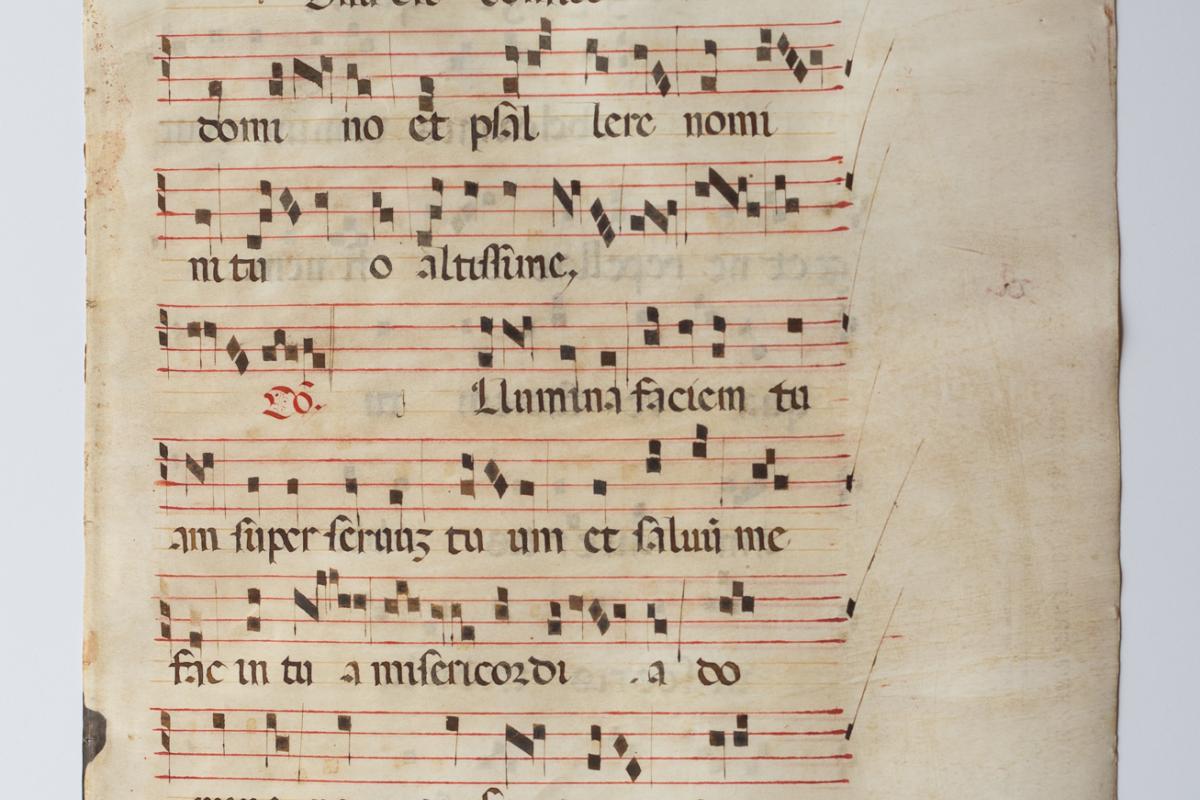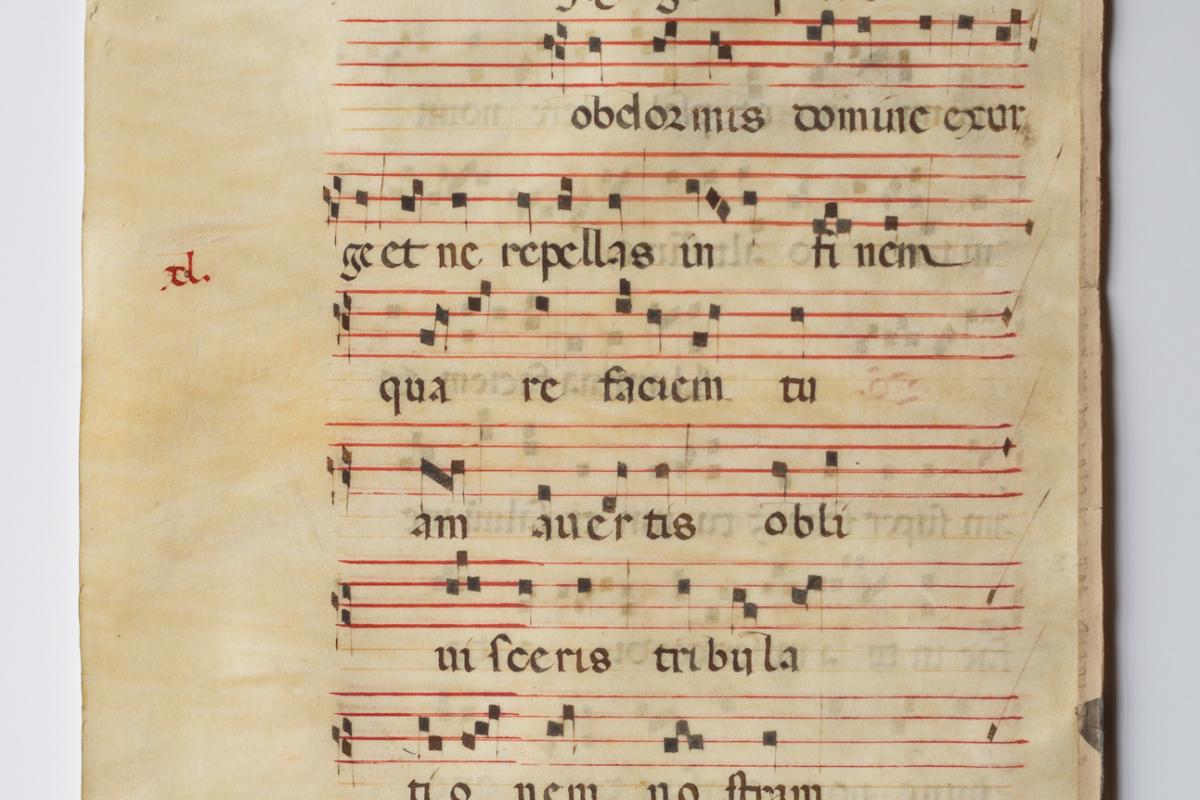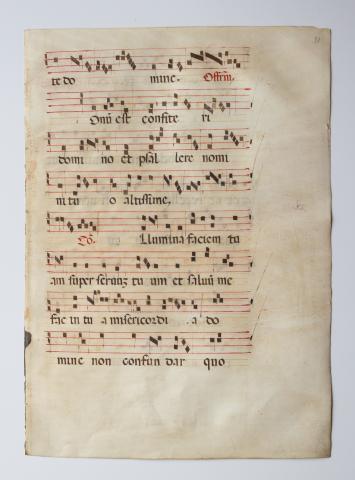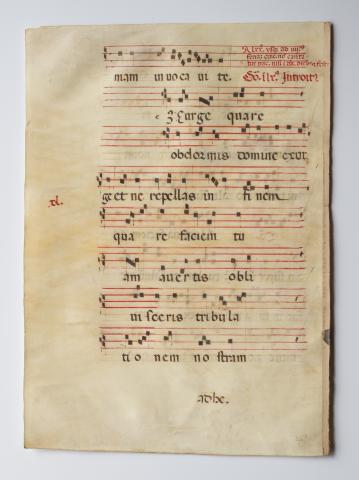Gradual Leaf
Gradual Leaf
14th century
Single leaf with verses for Saturday before sexagesima Sunday (recto)
ink on vellum
height 43 cm
width 30.5 cm
Melissa Medefessser, Medieval Portland Capstone Student, Summer 2014
This gradual leaf is a single leaf on thick vellum that was once part of a larger gradual: a liturgical book containing chants and music for Mass in the Roman Catholic Church. Dr. Wilma Louis Fitzgerald (1928-2013), who had previously studied the manuscript, dated it from the fourteenth century from an unknown place of origin. The John Wilson Rare Book Room at the Multnomah County Library has no record of its acquisition, however, it is known to have been in the collection since before 1997.
The gradual leaf measures 430 mm x 305 mm and was intended to be large enough to be seen and sung by a choir. "XL" appears in red ink in the left margin on the verso of the leaf. "350" has been written in pencil on the lower corner of the verso and "31" appears at the top right of the recto. Each side of the leaf contains eight lines of music with the Latin chant written beneath it. The writing appears neatly written and legible in bold black ink. The letter size remains consistent throughout the verses. The stave consists of four red lines with black square neumes. The chant has a monophonic (single-lined) melody indicating a Gregorian chant.
Single neumes were sung to each syllable beneath them. Several connected neumes, known as melismas, also appear on the leaf. The melismas were sung as successive notes to a single syllable. The square shape of the neumes is typical of medieval European notation after the thirteenth century.[1]
Three verses for Mass are depicted on the leaf, and the name of each verse is emphasized in red. According to Dr. Fitzgerald, the Offertory and Communion verses on the recto of the leaf were verses for the Saturday before Sexagesima Sunday, while the Intriot on the verso was for Sexagesima Sunday. The Masses take place eight weeks before Easter and two weeks before Lent in the Roman Catholic Church.
The Offertory of the gradual leaf is three lines long and the Communion has its final fourth line on the verso. Each of these verses can greatly vary in length, but Offertories tend to be more melismatic.[2] Introit and Communion verses general use a simple neumatic style.[3]
The gradual leaf appears very austere without any of the illumination or pictorial imagery of grander medieval manuscripts. Although there is no way of knowing for certain, it is possible that the other pages from the gradual did include decoration and additional color. Regardless, it is clear that this leaf was handwritten with care and skill.
Notes
[1] Nicolas Bell, Music in Medieval Manuscripts (Toronto: University of Toronto Press, (2001), 27.
[2] Willi Apel, Gregorian Chant (Bloomington: Indiana University Press, 1958), 367.
[3] Ibid., 311.
Bibliography
Apel, Willi. Gregorian Chant. Bloomington: Indiana University Press, 1958.
Bell, Nicolas. Music in Medieval Manuscripts. Toronto: University of Toronto Press, 2001.
Fortescue, Adrian. "Gradual." In The Catholic Encyclopedia. Vol. 6. New York: Robert Appleton Company, 1909. Accessed July 23, 2014. http://www.newadvent.org/cathen/06715a.html.
Yudkin, Jeremy. Music in Medieval Europe. Englewood Cliffs: Prentice Hall, 1989.
"Wilma Louis Fitzgerald, SP." Bonney-Watson. September 2013. Accessed August 10, 2014. http://bonneywatson.com/obituaries/2013/09/Wilma-Louis-Fitzgerald-SP.html
Wilma Fitzgerald, PhD, SP - Quoted with permission from an unpublished study
Graduale. Offertory and Communion verse of Saturday before Sexagesima Sunday, Introit for Sexagesima Sunday. One remarkably heavy vellum leaf foliated 31 in lead. 430 x 305 (320 x 205) mm. Eight lines of music with neumes on four red lines. On verso side a catchword: ad he. 350 added in lower right margin and in mid margin on left in red: XL
// [Tractatus. V. Quia apud te propiciacio est et propter legem tuam sustinui] te domine. Offertorium: Bonum est confiteri domino et psallere nomini tuo altissime. Communio: Ilumina faciem tuam super seruum tuum et saluum me fac in tua misericordia domine non confundar quo-
[verso]
niam invocaui te. A LXX [i. e. Septuagesima Sunday] usque ad IIIIam feriam cine[rum] non cantatur trac. nisi in dominica, diebus, et festis. Dominica in LX [i e. Sexagesima Sunday] Introitus: Surge [exsurge] quare obdornis domine exurge [exsure] et ne repellas in finem quare faciem tuam auertis obliuisceris tribulationem nostram [adhesit in terra uenter nosier exsurge domine adiuua nos et libera nos].




